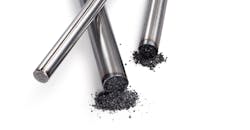Can Magnesium Treatment Be Reproducible, Transparent and Traceable?
Q: There are several production methods in which an iron alloy can be produced. However, only a few of them meet the requirements of tomorrow. Why and how does a foundry choose the cored wire process?
A: The requirements of foundry customers are becoming highly customized and individuality has also found its way into the series production. Legal and environmental standards encourage foundrymen to question the existing manufacturing process even more. Are you wondering whether your existing iron treatment process can withstand these requirements?
The most widespread ductile iron treatment methods are tundish-cover and the sandwich method. While each has its advantages and disadvantages, when thinking about reproducibility and traceability, these treatment methods must be challenged by more sophisticated process. In both cases, alloys are added to empty ladles and prior to tapping. Irreducible error in form of fluctuations in iron temperature, iron chemistry, tapping rate, and treatment size will heavily depend on the skill of the operators and will further displace from its mean from shift crew to shift crew.
On the contrary, the cored wire process’ unparalleled reproducibility is achieved because treatment parameters are calculated only after the ladle has been filled and all relevant iron characteristics properly measured, which deems it independent from the prior process variations.
Another consideration is the protection of employees from emissions generated during magnesium treatment. For several reasons, the exhaust system is habitually installed further away from the treatment ladle. This results in substantial release of effluents into the production hall or demands a very high capacity purification system capable of handling enormous air flow. With wire treatment, pollutants are confined to and readily captured right where they occur. A much higher level of efficiency and effectiveness is thus achieved.
Above all, iron treatment with cored wire offers the possibility of precise analysis guidance, cost control, and documentation. The knowledge of the treatment ladle content characteristics allows for precise calculations to be made. As a result, desired target values are achieved in a consistent manner, thus compensating for the fluctuations in the base melt and tightening the production range. When wire injectors are integrated to the existing equipment database (cooling curve analysis, thermal probes, scales…), this calculation occurs automatically on the fly at a mere push of a button.
From the wire perspective, particularly relevant parameters are the composition of the filling powder and the wire diameter. Which brings us to another benefit of cored wire. The cored wire composition is completely flexible and often is fully tailored to a particular customer’s process needs. Multi-feed setup is available too, whether that be multiple lines of the same wire for large treatments of 50 metric tons, or each line carrying a different type of wire, as in the SinterCast™ process in the production of compacted graphite iron (three wires: magnesium treatment, magnesium correction, and post inoculation.) This promotes a more efficient workflow.
Documentation and traceability are ensured via the wire injectors’ software database. In a similar fashion, any manual intervention that may be necessary, e.g., by post-treatment, also is logged automatically and accounted for in subsequent treatments.
Another important consideration for the foundry, apart from technical feasibility, is the question of the economic viability. The team of professionals at ASK Chemicals has been advising customers on cored wire implementation across the globe for more than two decades. ASK Chemicals together with the customer can prepare, if desired, a theoretical cost analysis comparing the existing process with the cored wire method. Furthermore, mobile wire injectors are available as loaners for initial qualification, to demonstrate practical benefits. This means that after the validation stage has been carried out, an actual data-driven basis for decision-making is readily available.
Join the Conversation. Email Your Questions for ASK Chemicals Share your insights, opinions, and elaborate on the questions and the experts' answer(s). You must be logged in to the website in order to post your comments.
